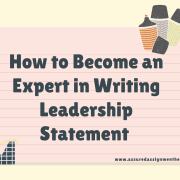Due Date: Friday 8 December (8pm AEDT)
Word Count: 1200 words (+/- 5%)
Weight: 30%
Referencing: You MUST use the following reference guide – Deakin guide to APA7 referencing. Warning: in-text references must provide the page number when provided in the source document. When the source does not contain pages numbers you must provide a section heading and/or paragraph number. See pages 12-13 in the guide as a starter.
Assignment Overview
This assignment is NOT about planning a new campaign – that is assignment 2. Assignment 1 is about using public relations theories and models encountered in the readings and in weeks 1-4 to show you can recognise and critically evaluate how an organisation uses public relations to respond to a particular issue. You will also conduct desk research to explain your organisation’s issue and their public relations response.
In assignment 2 you will do further desk research on the same organisation and develop your ideas for a campaign in a simple 8-step public relations plan.
Essay question: How does the non-profit charity Reading Out Of Poverty (ROOP) use public relations to encourage target publics to donate pre-loved books which will be given to children from disadvantaged backgrounds. Start here to learn about ROOP: https://roop.org.au/
WARNINGs:
- This is an essay about public relations, target publics and tactics, it is NOT an essay about literacy, donations, and volunteering broadly. If you are unclear about the distinction review your understanding of what public relations is. Participation in seminars will also help you here.
- Do NOT provide a history of ROOP. You can introduce the charity in one-to-two sentences.
- Do NOT contact Roop for the purpose of the assignment. You will be able to locate the information needed via desk research.
Instructions: Write an essay that:
- Defines public relations drawing on definitions encountered in your readings. You MAY NOT use direct quotes. Instead, paraphrase – which means writing definitions in your own words citing the sources that informed your definition (in-text and in your reference list). Use unit reading to inform your definition and explanation of public relations. Relying on direct quotes for definitions does not demonstrate how well you understand terms.
- Explains how ROOP uses public relations to build relationships with target publics? Your essay needs to identify different target publics relevant to the organisation and issue. Cite sources relied upon (in-text and in your reference list).
- Identifies and classifies public relations tactics they use. Your response should also address why public relations is more than simply advertising and marketing communications (e.g., promoting products). Cite sources relied upon (in-text and in your reference list).
Your essay must include a clear scholarly contention in relation to the essay question drawing on public relations readings from topics 1 to 4 and provide examples of communication tactics used by ROOP to illustrate points made.
Pointers
You will be using ROOP as the basis for Assignment 2 (the plan). The rationale is:
- The research you do for this assignment provides input into Assignment 2.
- You will receive formative feedback that may help you with Assignment 2.
In your essay, you must:
- Draw on a minimum of 6 different prescribed readings from topics 1-4
- Conduct your own desk research to help you understand the issue, factors in the organisation’s external environment, target publics, and tactics used. You should draw on a minimum of 4 evidence sources to help you. You can find information located at your organisation’s website and their social media pages. You may also find information in news stories about the charity. Ensure you complete the Library module before attempting desk research.
Writing your essay
Completing assignments is a process. The steps set out below are designed to help you develop a methodical approach to the essay – avoid the temptation to jump straight to Step 5. At each step, consider whether you need help, and where you can go to get help. For example, your tutor can help you with questions related to comprehension of the essay topic and unit content/readings. You should also explore Study Support help options: https://www.deakin.edu.au/students/study-support Pay attention to the tiles for academic integrity and study resources.
Step 1 Task Understanding
- Read the Instructions carefully and note the due date
- Analyse the essay topic, ie., content terms, directive terms, and limiting terms. If you don’t know what these are how do you find out what they mean?
- Read the Marking Rubric and make note of any elements about which you are unsure. You can then ask your tutor questions about them in seminars
Step 2 Topic Research
- Read the Library Search Tips (see library website and complete library module)
- Make sure you understand the difference between scholarly sources and desk research. After completing the library module, if you are still unsure, ask your tutor.
- Where will you locate the different type of sources you need?
- What search terms will you need for locating background information to help you understand the issue from the perspective of a public relations intern?
- What online resources that belong to your organisation will you need to review to find examples of their current public relations activities pertaining to the essay topic?
Step 3 Critical Reading: Identify which readings from the Study Guide will help you best.
- Consider the author’s purpose: why has the author written the material? Are these purposes explicitly stated? Are these implicitly stated?
- The author’s approach: what are the author’s underlying assumptions? Are these explicitly stated? Is there any proof of bias?
- Content: what is the author’s thesis? How do they develop the thesis? What evidence, examples, or explanations are used?
- How do terms, models, and concepts help you analyse and explain different aspects of your organisation’s treatment of the issue and use of public relations tactics? Importantly, what is not said about the topic by the organisation? Answering this question can help you identify areas which need further desk research. However, avoid the temptation to take a surface approach to research the organisation’s communication. Explore their website fully, and review their social media activities.
Step 4: Essay Plan. Plan your essay using this structure:
- Introduction – for an essay of this length allow one paragraph (approx. 10% of the word count).
o Introduce the essay topic (drawn from the essay question) and why it is important.
o Clarify how you intend to interpret and/or limit your response to the essay question.
o Tell the reader how your essay is to be structured in responding to the question. - Body: The body of your essay is comprised of paragraphs. Allow one point per paragraph using the following formula and this will help you work out how many paragraphs are needed.
o Topic sentence which signals the focus of the paragraph
o Sentences which develop the focus of paragraph to help you respond to the essay question.
These should be a mix of evidence and analysis.
o Scholarly sources and examples are correctly cited using the Deakin APA7 referencing guide.
o Concluding sentence summarising the point(s) of the paragraph and/or transitioning the reader to the next paragraph. - Conclusion: Remind the reader of the essay question and your key conclusions, but don’t simply restate the introduction or the essay question.
- Reference List: Stars on a new page and includes all references you cited in the body of your essay, formatted using APA7. To avoid plagiarism, you must give credit if you use the words or ideas of someone else.
- You may NOT use generative AI tools to help you write the essay.
- For additional assistance refer to the Deakin essay writing guide and planner:
https://www.deakin.edu.au/students/studying/study-support/academic-skills/essay-writing and review other resources in the assignment folder.
Step 5: Write your Essay. Write a draft first and then edit:
- Check assignment instructions often to ensure you remain focused on the task. For example, if you write more than one or two sentences about the history of your charity you are off topic and should remove unnecessary text. This will free up words so you can address the essay question.
- Check assessment criteria in the rubric and discuss these with your tutor if you’re unclear about the rubric.
- Logic and coherence in an essay are connected but different. Attention to logic ensures your ideas are well-structured and sequenced effectively so they are not jumping about and leading to errors such as repetition. Coherence in your essay is demonstrated by logical transitions and connections between sentences and paragraphs. Combined, logic and coherence aid readability.
- During editing check sentence structure and remove conversational or vernacular expressions. For example, Organisation X has an awesome approach to public relations. Awesome is not appropriate in this context. Look to your readings for clues about better words to use (per next point).
- Make sure you write with confidence and authority using relevant discipline terms drawn from study guide topics and readings).
- Be objective. There is no space for bias or emotion, only evidence-based analysis and discussion. For example, Homelessness is a really bad problem, and the government should be ashamed for allowing it to happen. The sentence (and underlined words) demonstrate value judgements and lack of analysis in the context of an essay of this type.
- Be accurate. You get NO MARKS for guessing. Inaccuracy alerts the marker to scrutinise your work.
- Direct quotes must NOT exceed 5% of the word count. Paraphrase and cite sources to show you understand the source and can communicate their ideas to support your points.











